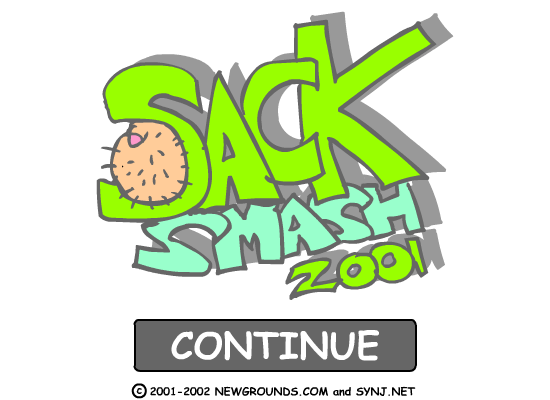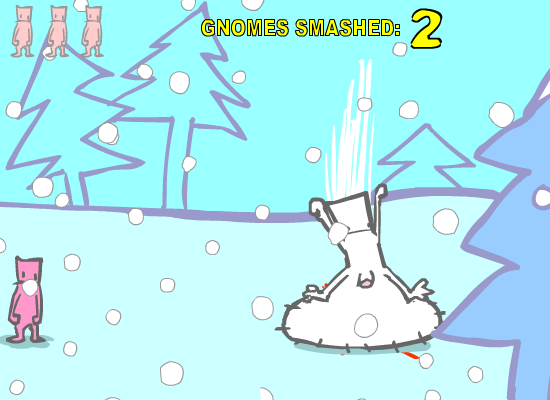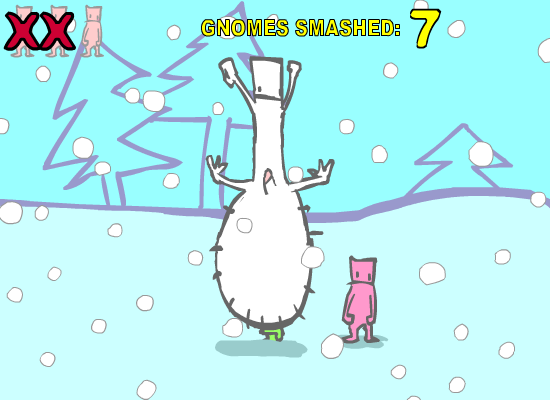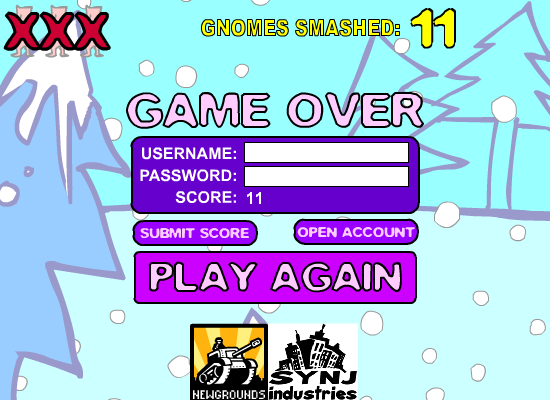Retro Replay Review
Gameplay
Sack Smash 2001 delivers a deceptively simple premise that belies a surprisingly addictive core loop. Players control a bouncy white creature, affectionately known as “the sack,” which automatically hops up and down as it scrolls from left to right. Your only inputs are the left and right arrow keys, making the game immediately accessible yet challenging to master. The objective is straightforward: squash as many green gnomes as possible while avoiding the pink ones. This binary target system creates a constant tension that keeps you on edge from the first bounce.
(HEY YOU!! We hope you enjoy! We try not to run ads. So basically, this is a very expensive hobby running this site. Please consider joining us for updates, forums, and more. Network w/ us to make some cash or friends while retro gaming, and you can win some free retro games for posting. Okay, carry on 👍)
Despite the minimal control scheme, Sack Smash 2001 manages to introduce depth through level design and pacing. The green gnomes appear in clusters or quick succession, rewarding precise timing and positional awareness. The pink gnomes, on the other hand, sneak into emerging gaps with fewer visual warnings, forcing split-second decisions. The absence of a time limit or health bar means errors are costly only in terms of immediate failure: once you accidentally squish three pink gnomes, the run ends. This “one more try” approach encourages repeated attempts, which is a hallmark of many successful arcade-style titles.
Another element that elevates the gameplay is the risk-reward dynamic. As you accumulate points by stomping green gnomes, you begin to chase high-score thresholds that dictate how daring you’re willing to be. Do you risk a tricky maneuver to catch a last-minute group of green gnomes near several pink ones? Or do you play it safe and hang back until the coast is clear? These split-second judgments provide a satisfying mental workout without overwhelming newcomers.
Graphics
True to Dan Paladin’s signature aesthetic, the visual design of Sack Smash 2001 is bold, cartoonish, and unapologetically quirky. The backgrounds are minimalist—often flat planes of color—allowing the colorful gnome characters and the white-sack protagonist to stand out sharply. This uncluttered approach not only lends clarity to the action but also gives the game a distinctive stylistic identity that feels both retro and fresh.
The green and pink gnomes are easily distinguishable, thanks to their vibrant hues and simple, silhouette-like shapes. Their animations—tiny hops, startled flails, and flattened pancaking—are exaggerated just enough to be visually satisfying. While the sprite work is intentionally low-detail, every frame is polished, ensuring that player focus remains on timing and positioning rather than deciphering busy visuals.
One of the more charming graphical touches is the sack creature’s oversized “package,” which jiggles with every bounce. This playful exaggeration lends a cheeky personality to the protagonist, reinforcing the game’s lighthearted tone. Though there are no dynamic lighting effects or 3D models, the crisp 2D presentation holds its own by leaning into bold lines, clear silhouettes, and lively motion.
Story
Sack Smash 2001 doesn’t offer a deep narrative or extensive lore. Instead, the game embraces simplicity: you are a bouncing sack on a mission to squash gnomes. This no-frills approach places the emphasis squarely on gameplay, letting the mechanics speak for themselves. Fans of narrative-heavy titles might find the lack of backstory disappointing, but those seeking an old-school arcade experience will appreciate the focus on pure action.
Despite minimal exposition, the game’s premise carries an underlying charm. Who—or what—is this sack creature? Why the obsession with gnome squashing? These unanswered questions spark the imagination and add a layer of whimsical absurdity. In lieu of cutscenes or dialogue, the playful visuals and tight mechanics serve as the game’s storytelling tools, conveying character through movement and design rather than text.
Subtextually, one could interpret Sack Smash 2001 as a tongue-in-cheek commentary on mindless arcade violence: you’re rewarded for indiscriminate stomping until you make a single mistake. Yet the bright palette and slapstick presentation ensure the tone remains lighthearted rather than grim. The lack of narrative depth is arguably a conscious design choice, keeping the experience brisk, focused, and endlessly replayable.
Overall Experience
Sack Smash 2001 excels as an impulse-buy title or a bargain-bin gem for quick, addictive play sessions. Its pick-up-and-play mechanics make it ideal for short bursts—whether you have five minutes during lunch or ten minutes before bed. The sheer simplicity of the controls belies the depth of challenge, creating a compelling “just one more run” momentum that can easily eat into your afternoon.
However, the game’s minimalism can also feel limiting over extended play. With no evolving environments, power-ups, or narrative progression, some players may find the core loop grows repetitive after repeated runs. There is no built-in health system or secondary objectives to mix things up, so the replay value hinges on self-imposed high-score goals or friendly competition with peers.
Overall, Sack Smash 2001 is a polished, fast-paced arcade experience that showcases Dan Paladin’s distinctive art style and knack for intuitive yet challenging design. While it won’t satisfy those craving sprawling worlds or deep storylines, it offers an electrifying rush for anyone looking to master its deceptively simple mechanics. If you appreciate concise, skill-based games with a dash of offbeat humor, this early Paladin work is well worth a spin.
 Retro Replay Retro Replay gaming reviews, news, emulation, geek stuff and more!
Retro Replay Retro Replay gaming reviews, news, emulation, geek stuff and more!









Reviews
There are no reviews yet.